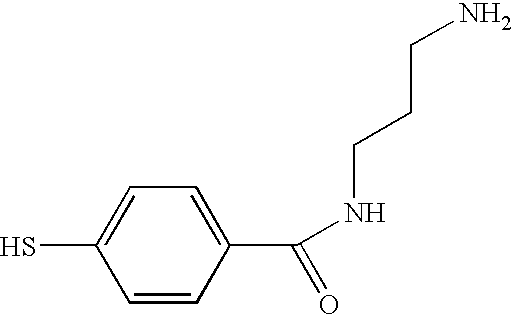Semiconductor nanocrystal probes for biological applications and process for making and using such probes
a technology of micro-crystal probes and nano-crystals, applied in scanning probe techniques, fluorescence/phosphorescence, instruments, etc., can solve the problem of difficult simultaneous or even non-simultaneous detection or discrimination between the presence of a number, and the limitation of the number of different color organic dye molecules which may be utilized simultaneously or sequentially
- Summary
- Abstract
- Description
- Claims
- Application Information
AI Technical Summary
Problems solved by technology
Method used
Image
Examples
example 2
[0125] To illustrate the formation of a semiconductor nanocrystal compound (comprising silica coated semiconductor nanocrystals linked to a linking agent) 200 .mu.l of 3-(mercaptopropyl)-trimethoxysilane and 40 .mu.l of 3-(aminopropyl)-trimethoxysilane were added to 120 ml of anhydrous 25% (v / v) dimethylsulfoxide in methanol. The pH of this solution was adjusted to 10 using 350 .mu.l of a 25% (w / w) solution of (CH.sub.3).sub.4)NOH in methanol. 10 mg of CdS or ZnS or ZnS / CdS coated CdSe nanocrystals were dissolved into this solution (prepared, in the case of CdS, by a technique such as the technique described in the aforementioned Peng, Schlamp, Kadavanich, and Alivisatos article; or in the case of ZdS, by the technique described by Dabbousi et al. in "(CdSe)ZnS Core-Shell Quantum Dots: Synthesis and Characterization of a Size Series of Highly Luminescent Nanocrystals," Journal of Physical Chemistry B 101 pp 9463-9475, 1997), stirred to equilibrate for several hours, diluted with 200...
PUM
| Property | Measurement | Unit |
|---|---|---|
| size | aaaaa | aaaaa |
| height | aaaaa | aaaaa |
| wavelengths | aaaaa | aaaaa |
Abstract
Description
Claims
Application Information
 Login to View More
Login to View More - R&D
- Intellectual Property
- Life Sciences
- Materials
- Tech Scout
- Unparalleled Data Quality
- Higher Quality Content
- 60% Fewer Hallucinations
Browse by: Latest US Patents, China's latest patents, Technical Efficacy Thesaurus, Application Domain, Technology Topic, Popular Technical Reports.
© 2025 PatSnap. All rights reserved.Legal|Privacy policy|Modern Slavery Act Transparency Statement|Sitemap|About US| Contact US: help@patsnap.com



